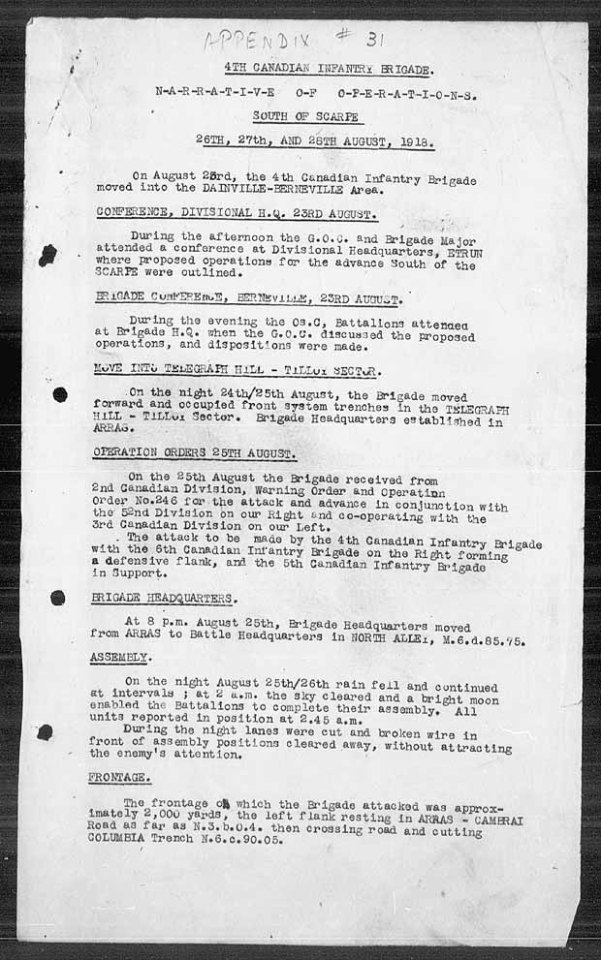#Guemappe
Text

Orderly room staff of the 1st (City of London) Battalion, Royal Fusiliers (City of London Regiment), keep the unit's paperwork up to date in a trench near Guemappe, 29 April 1917.
28 notes
·
View notes
Text
4TH CANADIAN INFANTRY BRIGADE NARRATIVE OF OPERATIONS. SOUTH OF SCARPE 26TH, 27TH, AND 28TH AUGUST, 1918.
4TH CANADIAN INFANTRY BRIGADE NARRATIVE OF OPERATIONS. SOUTH OF SCARPE 26TH, 27TH, AND 28TH AUGUST, 1918.

View On WordPress
#"B" Company 9th Battalion Tank Corps#18th Canadian Infantry Battalion#19th Canadian Infantry Battalion#20th Canadian infantry Battalion#21st Canadian Infantry Battalion#2nd Canadian Infantry Brigade#31st Canadian Battalion#3rd Canadian Division#4th Canadian Infantry Brigade#5th Canadian Infantry Brigade#6th Brigade#8th Canadian Infantry Brigade#Arras-Cambria Road#BUCK Trench#CABLE Trench#CURLEW Trench#EGRET Trench#enemy aircaft#Field Guns#Guemappe#Lewis guns#limbers#Lt. Col. B.O. HOOPER MC#Lt. Col. H.E. PENSE DSO#Lt. Col. L.H. MILLEN DSO#machine gun nest#MAJOR J.A. McINTOSH#MC#MINORCA TRENCH#NORTH ALLEI
0 notes
Photo

Orderly room staff of the 1st Battalion, Royal Fusiliers keep the unit's paperwork up to date in a trench near Guemappe during the Battle of Arras, 29 April 1917.
21 notes
·
View notes
Photo

© IWM (Q 5279) Royal Artillery observers near Guemappe, 29 April, 1917.
10 notes
·
View notes
Text
He is Still Living
He is Still Living

View On WordPress
#amputation#Arras#Battle of Amiens#Captain R.J. Renison#Dominion Orthopaedic Hospital#Guemappe France#Paisley Advocate#Paisley Ontario
0 notes
Photo

Regimental aid post of the Royal Army Medical Corps near Guemappe, 29 April 1917.
#ww1#wwi#great war#world war 1#western front#british army#RAMC#regimental aid post#trench warfare#military history
55 notes
·
View notes
Text
Private John Archibald McCallum of Cape Chin, Ontario. Farmer, husband and father of 4 children.
John Archibald McCallum was old by the standards of the average Canadian soldier enlisting in 1916. The attestation papers remark that his hair was “Black sprinkled with grey” when he joined the 160th Battalion at Lion’s Head, Ontario. Regardless of this sign of age the doctor examining him declared his physical development as “excellent.” The 160th was based in Walkerton, Ontario and in May of that year Private McCallum was home on sick leave. As he had been on active service since his enlistment since January 1916 perhaps, at night, after his four children had gone to bed his wife, Jean May, asked after him if he had made appropriate provisions in case he was killed in action. Or, perhaps it was that visit that made Private McCallum that he had a duty to his wife and children beyond his life.
On June 3, 1916, he wrote and signed his will.
I give, debise[i] and bequeath all my Real and [?] Estate of which I may die possessed in the manner following that is say:
All to my beloved wife Jean May. But should I die serving my country and my wife thereby receive a pension sufficient to support her, upon my youngest living child coming of age my property shall be divided as follows: each of my two daughters shall receive one-tenth of the estate and each of my two sons shall receive four-tenths thereof. Provided that should one or more die before the time set, their [?] shares shall be divided equally among the survivors.
Will of Private McCallum.
Secure in the knowledge that is wishes would be met upon his death this duty was discharged until August 29, 1916 when Private McCallum drew up a new will leaving this entire estate to his wife. This will is without any other provisions. It is unclear the reason for the new will and the lack of any provisions as in the first will. Certainly, there was no motivation to do this based on the imminent departure of the 160th Battalion to England as it did not depart Halifax until October 10, 1916, a little over 1 month from the creation of the second will. The will was signed and witnessed in Wiarton.[ii]
Regrettably the need for the will became realized on August 26, 1918. That date was the start of the Battle of Scarpe and into this the 18th Battalion engaged German forces successfully. The casualty cost, according to the 4th Canadian Infantry Brigade’s Narrative of Operations South of Scarpe 26th, 27th and 28th August, 1918 was 13 officers and 297 other rants. Private McCallum was on such casualty being killed in action on the 26th being killed instantly by a shell during the attack on Guemappe.
18th Battalion War Diary describing action on August 26, 1918.
18th Battalion War Diary describing action on August 26, 1918 continued.
Disposition of 18th Battalion soldiers on August 13, 1918.
Summary of casualties from the 4th Cdn. Inf. Bde. report.
A “Disposition” report dated August 13, 1918, indicated a total of 21 officers and 527 other ranks in the battalion. Thus, the Battalion suffered 62% casualties of its officers and 56% other rank casualties in this action.
[i] To leave real estate through the instrument of a will.
[ii] The witnesses appear to be Privates Thomas Johnston, reg. no. 651333 and John Spicer, reg. no. 651261. Both soldiers survived the war.
“But should I die serving my country…” John Archibald McCallum was old by the standards of the average Canadian soldier enlisting in 1916. The attestation papers remark that his hair was “Black sprinkled with grey” when he joined the 160th Battalion at Lion’s Head, Ontario.
#160th Battalion#Battle of the Scarpe#Cape Chin Ontario#Guemappe France#Jean May McCallum#Lion&039;s Head Ontario#Private John Archibald McCallum#Private John Spicer reg. no. 651261#Private Thomas Johnston reg. no. 651333#Wiarton Ontario#will
0 notes